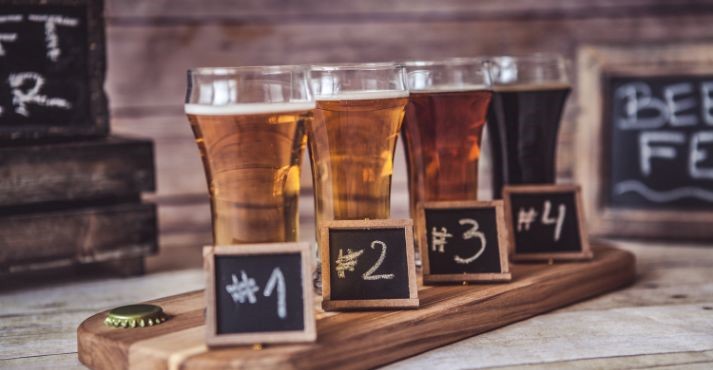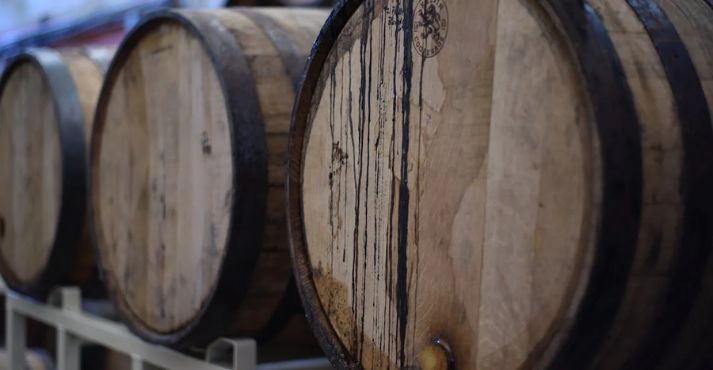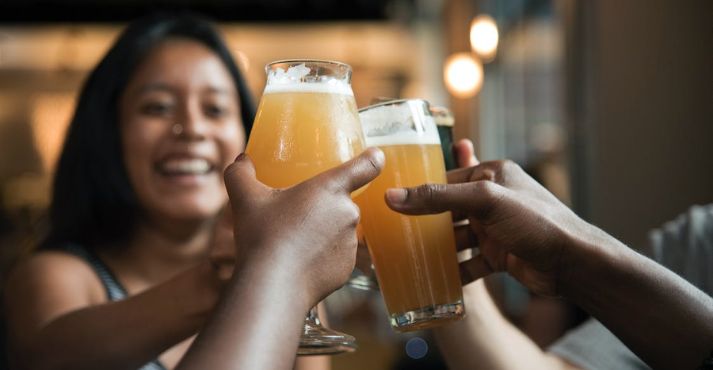Craft beer is experiencing a meteoric rise in Southeast Asia, with statistics revealing a remarkable surge in its popularity across the region.
According to recent data, craft beer consumption in Southeast Asia has witnessed a staggering growth of over 100% in the past five years alone. People love the variety it offers!
Craft breweries are popping up everywhere, from Thailand to Vietnam and Singapore, each offering a unique range of flavors and styles.
In this article, we’ll explore the question of craft beer, investigate the fascinating history of craft beer in the region, explore the different types and flavors available, and take a closer look at what makes craft beer so unique.
So, whether you’re a seasoned craft beer enthusiast or just curious to learn more, stay tuned for an exciting insight into the world of Southeast Asian craft beer!
Defining Craft Beer

What is Craft Beer?
Craft beer stands out for its small-scale and hands-on production. It’s a type of beer that represents independent brewing, different from the large-scale beers you often find. Craft beer focuses on the skill and art of making beer.
Characteristics of Craft Beer
1. Small-Scale Production: Craft beer is typically brewed in smaller batches, allowing meticulous attention to detail and a focus on quality over quantity.
2. Independent Breweries: It is crafted by independent breweries, free from the control of large beverage corporations. This independence fosters a spirit of creativity and experimentation.
3. Flavor Diversity: Craft brewers prioritize flavor and variety. They often explore unique ingredients, styles, and brewing techniques to create a wide range of beer experiences.
4. Tradition and Innovation: Craft beer celebrates both tradition and innovation. Brewers draw inspiration from time-honored brewing practices while introducing new flavors and styles.
5. Community Connection: Many craft breweries engage with local communities, fostering a sense of connection and authenticity. Taprooms often serve as hubs for beer enthusiasts to experience fresh, locally brewed beers.
History of Craft Beer

The history of craft beer traces back to the late 20th century when a homebrewing revival sparked a movement that would redefine the beer industry worldwide.
This revival gained momentum in the United States in the 1970s and 1980s, fueled by a desire to break free from the homogeneity of mass-produced beers.
Homebrewers began experimenting with innovative recipes and techniques, laying the groundwork for the craft beer revolution.
Critical milestones in developing craft beer culture include the establishment of microbreweries and brewpubs, which provided platforms for small-scale brewers to showcase their creations.
Craft beer festivals also emerged as hubs for enthusiasts to gather, share their passion, and celebrate the diversity of flavors and styles.
The craft beer scene in Southeast Asia has unique characteristics. Breweries in the region often incorporate local ingredients and flavors, infusing their beers with a distinct regional identity.
Additionally, certain beer styles, such as fruity and tropical ales, have gained popularity among Southeast Asian drinkers, reflecting their preferences for refreshing and vibrant flavors.
Influential Figures and Milestones
In the craft beer world, figures and events stand out, impacting this dynamic industry. Let’s explore some key pioneers and influences that have played a pivotal role in shaping craft beer.
Craft Beer Pioneers
Craft beer owes much of its growth to visionary pioneers who dared to challenge brewing norms. People like Fritz Maytag, who revitalized Anchor Brewing Company in the 1960s, and Jim Koch, the founder of Samuel Adams, blazed a trail for small, independent breweries.
Their commitment to quality and tradition laid the foundation for the craft beer movement.
Beer Festivals
Beer festivals have become integral to the craft beer story. Events like the Great American Beer Festival and the Oregon Brewers Festival provide platforms for brewers to showcase their creations and for beer enthusiasts to explore various styles.
These festivals celebrate beer culture and are a hub for innovation and camaraderie.
Impactful Events in Brewing
Throughout history, certain events have left a profound mark on craft beer. The legalization of homebrewing in the United States in 1978 ignited experimentation and creativity among beer lovers.
Collaborative brewing projects, like the “Mikkeller effect,” have fostered cross-cultural brewing partnerships, pushing the boundaries of flavor.
Craft Beer Comparison with Other Beer Types
Craft Beer vs. Regular Beer

Craft beer and regular beer seem similar, but they’re different. Although they both start with the same essential ingredients, the way they’re made and their flavors are unique. Let’s examine what distinguishes craft beer from regular beer and why many people love it.
Brewing Scale
Local breweries make Craft beer in small batches, focusing on quality and creativity. Regular beer is mass-produced by big companies, aiming for consistency. Craft beer offers more variety, while regular beer tastes the same every time.
Ingredients
Craft beer uses quality ingredients from nearby farms, giving it unique flavors. In contrast, regular beer relies on standardized ingredients that might have less character. So craft beer often tastes fresher and more exciting because it’s made with care and specialty.
Flavor And Variety
Craft beer comes in many flavors, such as fruity, spicy, or chocolatey, offering many choices. Regular beer brands usually have fewer options and stick to primary flavors. Craft beer is like a big-taste adventure, while regular beer is more like sticking to the same old flavors every time you drink it.
Brewing Techniques
Craft brewers make beer with special care, using traditional methods instead of big machines. They focus on making each batch unique and trying new things to create delicious flavors. Craft brewing is like a craft project, where every detail matters, while regular beer is made quickly and has fewer varieties in taste.
Consumer Perception
People increasingly choose craft beer because they appreciate its realness and how passionate brewers carefully make it. Craft beer stands out because it’s not mass-produced like other beers. People enjoy the unique flavors and quality that come from small breweries. It’s like choosing a homemade meal over fast food because it feels more special and genuine.
Craft Beer vs. Commercial Beer

Craft beer and commercial beer represent two distinct paradigms within the brewing world, differing in scale and their fundamental brewing philosophies.
Small-Batch Brewing vs. Mass Production
One of the most significant differences lies in the scale of production. Craft beer is characterized by small-batch brewing, where each batch is meticulously crafted on a limited scale. This allows for greater control over the brewing process, with a heightened emphasis on quality and flavor.
In contrast, commercial beer is produced on a massive scale, often by large beverage corporations. Mass production prioritizes efficiency and consistency, resulting in uniform beers that may need more depth of character found in craft brews.
Brewing Philosophy
Craft beer embraces a brewing philosophy that celebrates creativity, innovation, and exploration. Craft brewers are known for experimenting with diverse ingredients, styles, and techniques, resulting in a kaleidoscope of flavors and a constant quest for uniqueness.
On the other hand, commercial beer adheres to established recipes and standardized processes to maintain consistency across vast quantities. While this approach ensures uniformity, it may limit the diversity and complexity of flavors that craft beer enthusiasts seek.
Craft Beer Ingredients
Malt, Hops, and Yeast: The Core of Craft Beer
Craft beer is a harmonious blend of flavors, and at its core are three essential ingredients: malt, hops, and yeast. These components are the foundation of every brew, each playing a unique and vital role in crafting the character of craft beer.
Malt: The Flavor Backbone
Malt, typically sourced from barley, provides the sugars necessary for fermentation. It also introduces a range of flavors and colors to the beer, from the sweet richness of caramel malts to the roasted bitterness of chocolate malts.
Craft brewers carefully select specific malts to create their brews’ desired taste and appearance, making malt a fundamental element of beer flavor.
Hops: Adding Spice and Aroma
Hops are craft beer’s spices and aromatic elements, offering a spectrum of scents and tastes.
They bring bitterness to counterbalance the sweetness from the malt and infuse the beer with various aromas, from piney and citrusy to floral and spicy. Craft brewers use hops strategically to achieve their creations’ perfect balance and complexity.
Yeast: The Alchemist of Fermentation
Yeast, often unsung in brewing, transforms sugars from malt into alcohol and carbon dioxide, creating the effervescence and alcoholic content of beer.
Different yeast strains also contribute distinct flavors and aromas, ranging from fruity and estery notes to earthy and spicy undertones. Craft brewers select yeast strains carefully to craft their beer’s unique profile.
Water Quality: The Hidden Art of Brewing
While malt, hops, and yeast often steal the spotlight in craft beer discussions, water quietly plays an equally crucial role, with its quality and regional characteristics significantly influencing the outcome of each brew.
The Essence of Brewing Water
Water is the unsung hero of beer. It serves as the canvas upon which brewers paint their flavorful creations. The mineral content, pH levels, and water source can dramatically impact a beer’s taste, mouthfeel, and overall quality.
Regional Influence
One of the remarkable aspects of craft beer is its ability to capture the essence of a region. Water, sourced locally, carries its environment’s distinct flavors and characteristics.
Brewers in different parts of the world use this regional water profile to their advantage, crafting beers that reflect the unique qualities of their location.
Water Chemistry: Balancing Act
Brewers pay meticulous attention to water chemistry, adjusting mineral content and pH levels to align with the style of beer they intend to create.
This careful balance allows them to enhance certain flavors, create crispness, or achieve a particular mouthfeel, contributing to the beer’s overall profile.
Craft Beer Styles

Variety of Styles: The Rich Palette of Craft Beer
Craft beer is a world of flavor diversity, where brewers showcase various styles. From the bold bitterness of IPAs to the dark richness of stouts and the tangy zing of sours, craft beer offers a broad spectrum of tastes to satisfy every palate.
IPAs: A Hoppy Journey
IPAs, short for India Pale Ales, are celebrated for their robust hop flavors. They come in various profiles, from the citric and piney notes of American IPAs to the more earthy and floral tones of English IPAs. With varying levels of bitterness and aroma, IPAs provide a playground for hop enthusiasts.
Stouts: Deep and Flavorful
Stouts delve into the world of roasted malt goodness. These beers span the spectrum from smooth and sweet milk stouts to the bold bitterness of imperial stouts. Often characterized by hints of coffee, chocolate, and dark fruits, stouts are favored by those who relish rich and complex flavors.
Sours: A Tangy Twist
Sour beers offer a distinct and refreshing experience with their tartness. From Berliner Weisses to Goses and wild ales, sours can be fruity, funky, or intensely tart. They bring a unique and refreshing dimension to the craft beer landscape.
Lagers, Ales, and More
Beyond these main categories, craft beer enthusiasts can explore various lagers, ales, hybrids, and experimental styles. Each style brings its flavors and aromas, allowing brewers to push the boundaries of creativity.
Craft Beer Culture in Southeast Asia

Craft beer is becoming increasingly popular in Southeast Asia, with more breweries, bars, and festivals popping up across the region. People are interested in craft beer because it offers unique flavors and experiences.
Millennials, expats, and tourists are all drawn to craft beer because they appreciate its authenticity and quality. Craft breweries in Southeast Asia often use local ingredients, adding a special touch to their beers.
Beer bars and festivals allow people to explore craft beers and connect with fellow enthusiasts. Overall, the craft beer scene in Southeast Asia is vibrant and growing, attracting a diverse group of beer lovers.
In Southeast Asia, craft beer festivals like Brewtopia in Thailand and Beerfest Asia in Singapore have gained popularity. These festivals attract beer enthusiasts from around the region to sample craft beers, including unique brews from local breweries.
They provide an excellent opportunity for attendees to explore different flavors, learn about brewing techniques, and connect with fellow beer lovers in a lively and festive atmosphere.
Additionally, events like the Ho Chi Minh City/Saigon Craft Beer Festival in Vietnam and the Oktoberfest Craft Beer Festival in Indonesia contribute to the growing appreciation of craft beer culture in Southeast Asia.
Key Players in the Craft Beer Market
In Southeast Asia’s bustling craft beer scene, breweries like Heart of Darkness Brewery and Brewlander & Co. are making waves with their innovative brews. These local favorites offer a variety of flavorful beers that cater to different tastes and preferences.
- Heart of Darkness Brewery: Known for its adventurous spirit, it experiments with unique ingredients and brewing techniques. Its Kurtz’s Insane IPA and Dream Alone Pale Ale are popular among craft beer enthusiasts for their bold flavors and creativity.
- Brewlander & Co.: With a focus on balance and approachability, Brewlander & Co. crafts beers like Wild IPA and Session IPA. They blend traditional brewing methods with modern twists, resulting in brews that appeal to a wide range of beer drinkers. In addition to these local breweries, international brands like Stone Brewing and BrewDog have also made their mark in Southeast Asia. These breweries bring a global selection of craft brews to the region, adding to the diversity of choices available to beer enthusiasts.
Craft Beer Pairing and Tasting
Craft beer pairing and tasting can be a delightful experience, especially with the diverse flavors found in Southeast Asian craft brews. Here are some simple tips to enhance your craft beer journey:
- Food Pairings: Lighter beers, such as pale ales and lagers, are good with seafood dishes or salads, while darker beers, such as stouts and porters, complement hearty meals like grilled meats or chocolate desserts.
- Glassware Selection: To capture their complex aromas, use a tulip glass or snifter for aromatic beers like IPAs and Belgian ales. Pilsner glasses are perfect for showcasing the clarity and enthusiasm of lagers, while pint glasses work well for enjoying straightforward ales.
- Tasting Notes: Take a moment to observe the beer’s appearance, noting its color, clarity, and foam. Then, breathe in the aromas deeply to detect any hints of hops, malt, or fruitiness. Finally, savor each sip, paying attention to the beer’s flavor profile, mouthfeel, and finish.
Frequently Asked Questions (FAQs)
Is craft beer stronger?
Craft beer’s strength can vary widely depending on the style and brewing process. While some craft beers may have higher alcohol content than mass-produced beers, others may have similar or even lower alcohol levels. It ultimately depends on the specific beer you choose.
Is craft beer a lager or ale?
Craft beer encompasses a wide range of styles, including both lagers and ales. Lagers are known for their crisp, clean taste and are fermented at cooler temperatures, while ales offer a broader spectrum of flavors and are fermented at warmer temperatures. Craft breweries often produce lagers, ales, and various other styles.
What is an example of craft beer?
The India Pale Ale (IPA) style is a famous example of craft beer. IPAs are known for their hop-forward flavor profile, characterized by floral, citrusy, and piney notes. Craft breweries worldwide produce a diverse range of IPAs, each with its unique blend of hops and malt, catering to different preferences and tastes.
Conclusion
In short, craft beer isn’t just a drink; it’s a different way of making beer. It’s like when someone who loves cooking tries out new recipes. Craft beer is a bit like that but with beer.
The craft beer movement is a story filled with history, creativity, and passionate brewers. To understand it better, let’s go back and see how it all started and grew over the years.
Craft beer has had a significant impact on how beer is made. It’s inspired new ideas and created a fun community of beer fans. So, the next time you enjoy a craft beer, remember all the hard work and passion that went into making it. Cheers to craft brewing!





























